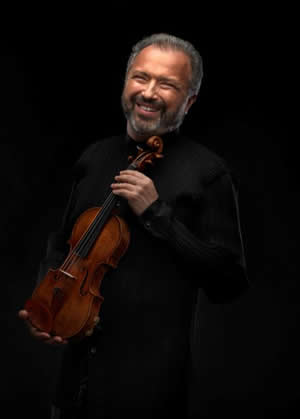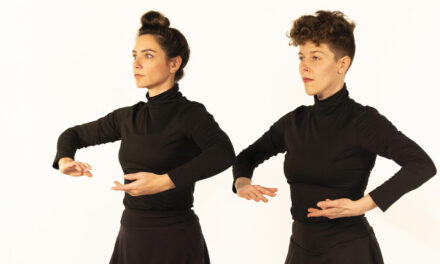It’s always a treat to hear Greensboro Symphony Music Director Dmitry Sitkovetsky (who was born and grew up in the USSR) bring Russian works to the stage. But when he also served as violinist for one of the pieces performed Thursday evening in the UNCG Auditorium, it promised to be a very memorable night.
UNCG’s War & Peace Imagined, “an extensive collaboration that explores aspects of conflict and its resolution from an array of perspectives” provided a perfect setting for what GSO called “War & Peace Reimagined.” Two works were programmed – the first written during World War I, the second during WW II.
Prokofiev’s Violin Concerto in D, Op. 19 was begun in Paris in 1915 but not performed until 1923 at the Paris Opera. It was presented Thursday not by the GSO, but by the UNCG Symphony, ostensibly part of that “extensive collaboration.” At the podium was Kevin Geraldi, UNCG director of orchestral activities. The work is in three movements: a moderate Andantino, a lively Scherzo marked “Vivacissimo,” and a concluding Moderato – Allegro moderato.
The opening movement finds the solo violin presenting wandering, ethereal passages over a subdued orchestra. The entire range of the instrument is explored, especially the extremely high registers. Translucent textures dominate most of the movement.
The second movement begins as a sprightly lark, with the energetic violin dancing its way through the score. Heavy-fisted peasant tunes provide contrast in the middle.
The third movement begins with music reminiscent of the first movement in character, but in the course of the movement come climaxes that could make Rachmaninoff proud. However, the movement concludes with the solo violin wistfully evaporating into the heavens.
Geraldi followed Sitkovetsky’s every nuance with clarity and authority; the collaboration between the two couldn’t have been tighter. The UNCG orchestra played more like a pro ensemble than a student group. Sitkovetsky’s playing was magnificent, electric – intonation, passion, and technical facility all served to bring the details of the score alive.
The UNCG Symphony was then replaced by the GSO and Sitkovetsky took the podium for Shostakovich’s large Symphony No. 8 in C minor, Op. 65. The work was written in 1943 during the Soviet turning point in World War II. However, one is hard pressed to find much optimism in the work’s five movements. Some have speculated that even though “Stalin had defeated the Nazis,” Shostakovich may have thought that fact would aid Stalin, granting him even more power than he already had.
Shostakovich described the symphony as “an attempt to reflect the terrible tragedy of war.” Indeed, the composer later wrote that he felt pain not only for those who were killed by Hitler, but also those that were killed on Stalin’s orders.
What one takes away from the long symphony is incredible tension and lack of resolution. The opening Adagio – Allegro non troppo movement, which begins with a jerky rhythm in the depths of the orchestra, reminds one of the opening of the composer’s Fifth Symphony. But the lyricism that follows in the earlier symphony here is replaced with unrelenting intensity, at one point increased by stratospheric horn writing. The climaxes are simply horrific.
Here, and throughout the symphony, Sitkovetsky strove for maximum drama, which the GSO returned in spades. To cite just one such moment near the middle of the movement would be when with the snare drum picked up the inexorable rhythm that chilled the listener to the bone.
The Allegretto second movement, which the composer described as “a march with elements of a scherzo,” futilely attempts to break the mood, but sounds more likely a mockery than relief. A piccolo solo, finely played by Carla Copeland-Burns, marked the middle section.
Perhaps the most accessible movement is the third Allegretto, with its motor rhythm and over which syncopated hammer blows play out. Brutal, banshee-like cries are superimposed on the texture, creating an overall creepy effect.
The Largo fourth movement, which opens with a stern outburst, is built around a recurring melody, called a passacaglia. The repetition of the tune, based in the strings, makes the movement somewhat static, or as one commentator stated, “frozen in time and space.”
The finale (which many liken to Beethoven’s Fifth Symphony because the mode changes from C minor to major) begins somewhat pastoral in nature with chirping woodwinds and bird-like trills. To be sure the movement includes some not-very-satisfying climaxes and rather failed attempts at resolution. The entire symphony concludes with low pizzicatos in the double basses.
The orchestra and conductor were able to maintain focus and passion, and perhaps most importantly, concentration, to the hour and 10 minute long work. Never did the energy or attentiveness flag.
Kudos to Sitkovetsky and the GSO for bringing such a powerful and interesting evening of music-making. The inclusion of the UNCG orchestra and the connection to UNCG’s year of “War and Peace Imagined” is a wonderful collaboration, one that we hope will continue into the future.
This performance repeats on 10/1. See our sidebar for details.












